Whilst sorting through the sub-basements of the cavernous
Reviewiera offices I came across a weathered and beaten 1976 copy of O'Donnell & Vaughan's
Portland; A Historical Sketch and Guide1.
The tour of Old Town is dynamite - offering of gems of a trashy past amongst the raw ingots of architectural wisdom. At the time of this writing, my preferred Portland history reading is Percy Maddux's
City on the Willamette; the Story of Portland, Oregon (1952), which is entirely & clearly drawn upon the rather spectacular accounts of the local newspapers as source material.
2 In a similar vein, the '76
Portland book, although perhaps not as rambling and anecdotal (its locational and historio-architectural in focus, to draw a contrast), is admirable in its acknowledgement of Portland's seedier past.
Of course, the difficult channel here, is often the "seedier," even "criminal," past of Portland tends to lean towards what could be described as the more "popular" elements of our polis' history. Heck, I'll confess the discovery of brothels of yore as more entertaining than the Rose Festival. How about this tidbit? In 1874 five women from the Temperance League were arrested for disturbing the peace by singing hymns in Portland saloons? Okay, perhaps that fact, alone, is rather drab. But, what if I stipulate the follwing? In 1874, there was one saloon for every 40 souls in town. Mmm-hmm. You'll tell all your friends that, won't you?
I gave the walking tour of Old Town an honest shot. However, Saturday Market was in full swing, & being aware of the history of the New Market block, Skidmore Fountain, etcetera, I sorta skipped that part. Coming up the waterfront, I noticed that the 223 S.W. Front street building turned out to be in my guide.
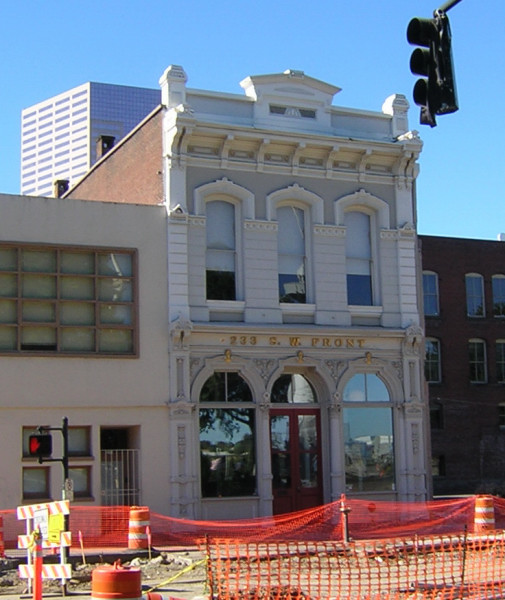
223 S.W. FrontDan Haneckow has covered this building
3 in far more detail than I could ever hope, but let's see what the '76 guide has to say.
This well-restored little building is a stunning example of the Italianate cast iron fronts of the 1870's. The iron, manufactured by a local foundry whose plaque is on the building's lower right corner, is used in the columns, pilasters and spandrel details. The ground floor fascade, ornate as a boudoir screen which it somehow resembles, is in contrast to the rather reserved second story, but at the top the froth comes back from in the chimneys cum finials and the ornamented pediment.
Such an elegant little building surely had elegent tenants, perhaps a perfumery on the ground floor an din the flat above a lady frown old and respectable who kept a canary and a pug. In fact, the ground floor was a drugstore, trusses in the window, while above was no lady with a boa but rather an accountant.4
This sort of "you'd think this is what this building is for, but you're wrong" rubic is an amusingly typical (& charming) aspect of the '76 guide's tone. Next up, the Blagen block just north of Saturday market.
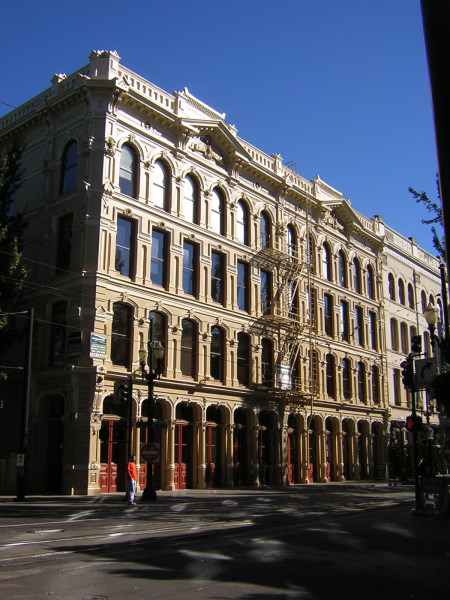
The Blagen Block. 78 NW Couch St.Sayeth the guide...
About the best remaing example of a Portland "commercial palace." Its construction is typical: wooden beams and joists, brick walls surfaced with cement plaster, an ensemble of cast iron ornament bolted to the walls. Finally, the whole painted in shades of gray and white. The principal cast iron elements in the Blagen Block are the ground floor colonnade plus a number of lions and ladies which at intervals ornament the whole fascade, the ladies with thier spiked crowns copies perhaps of the the Liberty erected two years before in New York's harbor. The fascade in generalis a grand exercise in fenestration, each story with its own order of arches, the whole composition topped by a parapet and two overhanging pediments beneath which shelter the buildings name and date. To visualize Old Town in its heydey, imagine long street vistas walled on either side by Blagen Blocks.5
This certainly is a compelling image: blocks upon blocks of Blagens. T'would truely be a little Brussels or some such, wouldn't it? Aye, what's this one 'round the corner, then? Still, a nice building, but lacking any historical
people history, y'know?
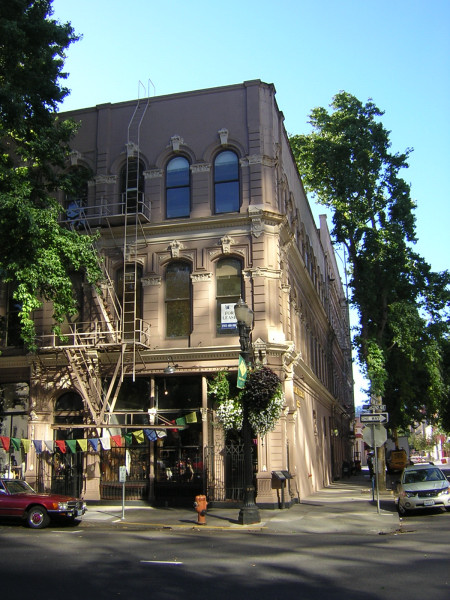
Merchants Hotel. 123 NW 2nd.Merchants Hotel, hm? Nice enough looking place.
The Merchants Hotel has led a lively life. Starting out as a hotel in 1885, it remained one for nearly 100 years, but along the way accommodated other activies as well: a dance hall, a cracker factory, a billiards room, a bar plus several apartments for single ladies with friends in the fleet. After World War I the building became a Japanese business complex: several professional offices, a Japanese grocer, the editorial offices of Japanese Oregon Weekly. In 1968 Mr. William Naito, the present owner, restored the building and it is now used for a range of interesting and useful activities. How nice that a building with a lively past now has a lively present.
The Merchants' Second Avenue fascade is pleasing enough with its cast iron pilasters and entryway in cream and white and gilt, but it is around the corner on Davis that the building presents its most impressive face--note quite a "palace" but nonetheless a fine three-storied screen of pilasters and arches. Midway in this fascade, an alley leads to a small courtyard: brickwalls, a fountain, ferns and in one corner, giving the court its character, arches silhoutted against a transformed shaft.6
First of all, the guide is absolutely correct in saying the Davis side is the more impressive - which is also the side I notedly did not take a picture of. Yeesh. Bonehead. But it is here at the Merchants we get a taste of Portland's "North End" & "Bowery" days, the salicious sort of stuff which tickles the Frank Miller in us all. Tell us more, oh 30-year-old walking tour book!
In 1889 the elegant West Shore magazine, a local publication, ran a full-page illustration of a "north end" Portland street. A ten-year-old boy lies sprawled on a curb dead drunk. From an open window a prostitute solicits. Three Chinese pose proudly in thier gambling establishment. Through all of this a Portland policement passes, tapping his way with a white cane, and bearing a sign which reads, "Please help the blind."7
Holy sparkle horses!! I'm rendered speechless! Let's move along!
Something sacred to cleanse the soul's palate, perhaps.
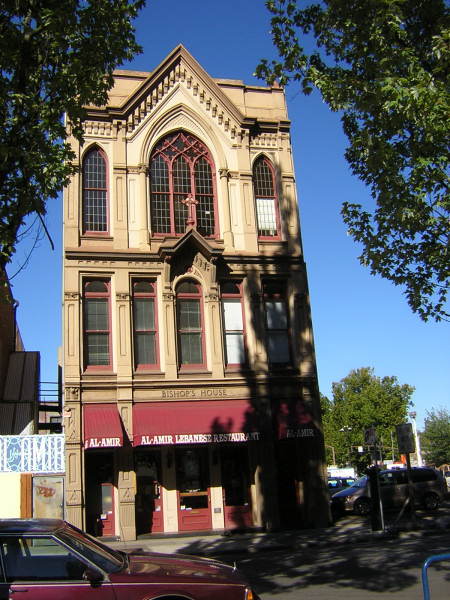
Bishop's House. 219-223 SW Stark St.In 1878 the Roman Catholics in Portland built a cathedral at the corner of Third and Stark, adding a year late this structure to house meeting rooms and other facilities. When the cathedral moves northwest towards the Irish in 1890's the building was sold to be occupied over the years by a succession of colorful tenants--a Chinese tong, a speakeasy, the A.I.A. In 1965 William Roberts, who has done several handsome restorations in the city, gave the decrepit old building a new and useful lease on life.
Aside from several churches, it the most gothic of any building in town, angular and pitched, well furnished with corbels, tracery and crockets, ecclesiatical as a miter which it in a way suggests. The best of the building is its third story triptych, two lancets bracketing a splendid arch of tracery and glass. What, one wonders, goes on behind this? What goes on is one of the most interesting interiors in town: a room 17 feet high, 24 feet square, giant baronial fireplaces to either side and a the end of this wall of mullioned glass, framing in its three intervals cityscape and hills. And to cap it all there was once a musicians' gallery. What a room it must have been: the flaming grates and candlelight, singers in the gallery, the lights of the town through the mullioned glass, and presiding in scarlet over scene, the legendary spellbinder, Archbishop Blanchet.8
The Bishop's House has drawn my gaze since I first laid eyes on it in high school on my way to the (previous location of) 2nd Avenue Records. I recall it literally stopping me in my steps. What was it & what was it doing there? And, as the guide correctly asks, what does goe on on that top floor??
Finished w/ this silly walking around nonsense, to Paddy's we ambulated for pints & a snapshot of the passing Council Crest 511.
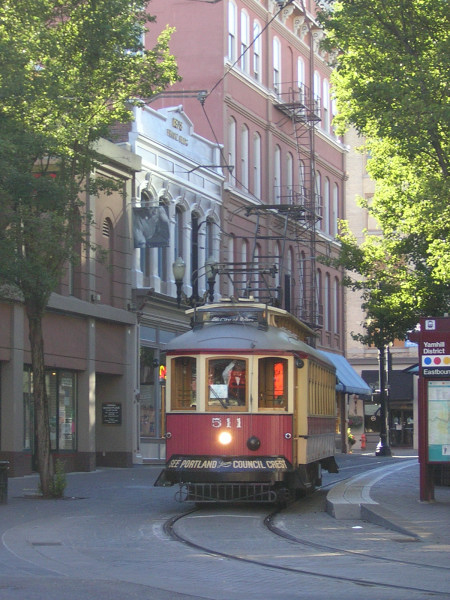
The building closest to the left is Bally's Fitness. The middle building is 122 SW Yamhill (I think - why don't I write this crap down?) & was built in 1885, or 1886. So was the taller building next to it (820 SW 2nd - again, I think). A pint of Harp for $5.00 is highway robbery.
-d.d.
1 Check it out on Amazon.com
2 'Tis a rambling book, as well. For a taste, consider this quote from the book jacket: "There was never a dull moment--runaways, parades, expositions, Chinese riots, tong wars." Makes my Portland blood boil w/ grindhosue pride, that does!
3 223 SW Front St., according to Dan Haneckow
4 Portland; A Historical Sketch and Guide. O'Donnell, Terence, and Vaughn, Thomas. Oregon Historical Society, Portland, Oregon. 1976. p. 108-109.
5 ibid. p. 96-97. [underlined] emphasis mine.
6 ibid. p. 98. [underlined] emphasis mine. Having visited eastern cities (esp. Buffalo) whose primes matched Portland's (c.1890s-1900s), I marvel at times at how, even though Portland has been certainly blessed w/ a certain vision & generally judicious foresight & planning - a terribly large credit as to the city's current beauty is just plain dumb luck. How fortunate, for example, Naito purchased & simply kept all these great old buildings downtown, when he, or someone else of different temperment, could have simply demolished them all. Brrr.
7 ibid. p. 35.
8 ibid. p. 105-106. Archbishop Blanchet, pictured below.
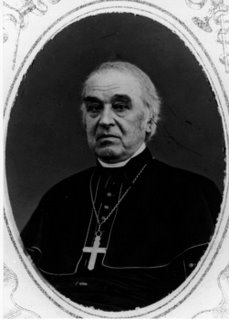
Hailing from Quebec. First Archbishop of the Archdiocese of Oregon City, later the Archdiocese of Portland. Would not approve of my popular historical tastes...








